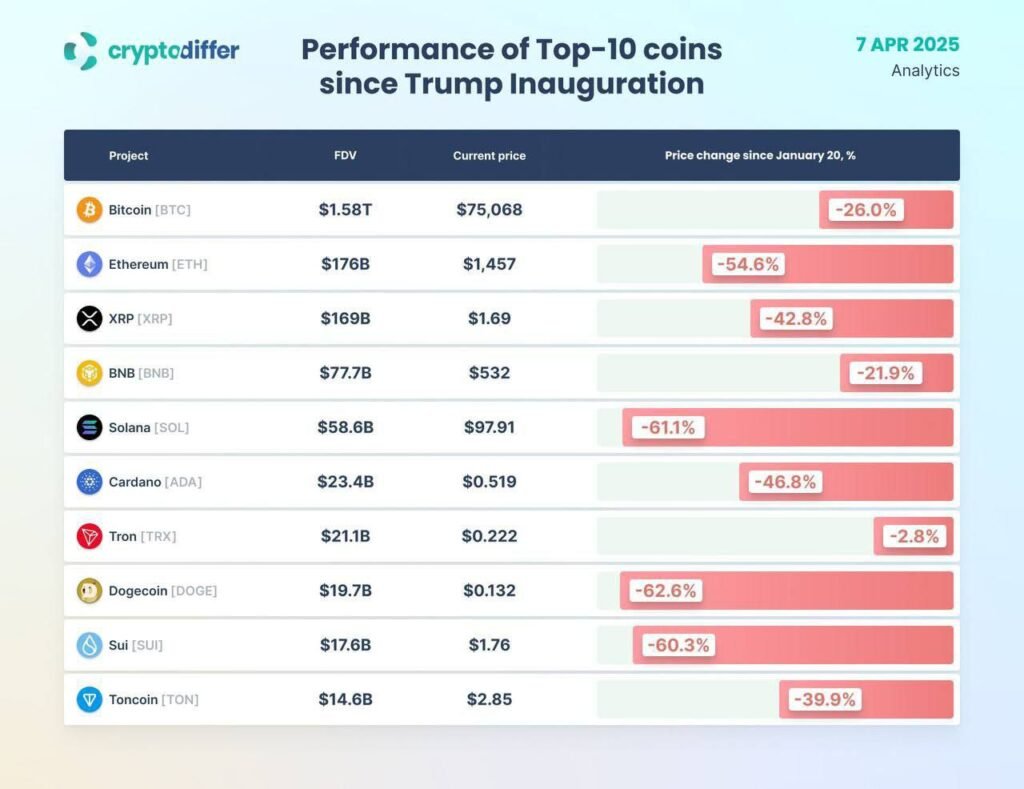The cryptocurrency market has recently experienced significant downturns, particularly among the top 10 digital currencies.
Several factors have contributed to this decline, including recent U.S. government policies and broader economic conditions.
Let’s see them below.
i. The Impact of U.S. Tariff Policies on Crypto
One major cause is the U.S. Tariff Policies.
On April 7, 2025, the U.S. administration implemented extensive tariffs, leading to a sharp decline in global markets.
Major stock indices such as the S&P 500 and Nasdaq Composite fell by approximately 9% and 10%, respectively.
This market turmoil extended to cryptocurrencies, with Bitcoin dropping 6.7% to $76,978.
Altcoins like XRP and Ether are experiencing declines of around 14%, reaching $1.78 and $1,507, respectively.
ii. Regulatory Challenges in Crypto
In addition to tariff-induced market instability, regulatory actions have further pressured cryptocurrencies.
In 2023, the Securities and Exchange Commission (SEC) went on a filing spree against many exchanges.
It filed lawsuits against major exchanges like Kraken and Binance, alleging the offering of unregistered securities, including tokens such as Cardano (ADA).
These legal proceedings led to significant price drops and delistings from platforms like Robinhood.
iii. Market Dynamics and Crypto Investor Behavior
Despite the easing of certain regulatory measures, the anticipated positive impact on the cryptocurrency market has not materialized.
For instance:
In January 2025, the SEC rescinded SAB 122, which had restricted banks from holding cryptocurrencies.
Even at that, major tokens like Cardano, Polkadot, and Uniswap experienced double-digit losses.
This suggests that regulatory relief alone may not suffice to bolster investor confidence or drive demand.
But does this mark the end of crypto?
What should crypto enthusiasts be doing now?
Let’s discuss that below.
Is Crypto Dead? – An Outlook on the Recent Happenings

Nah, crypto isn’t dead — but neither is it alive at the moment!
It‘s just in a weird place, depending on how you look at it.
Let’s break it down:
It’s not dead because:
- Bitcoin is still holding up – between ups and downs, the #1 cryptocurrency is still waxing strong
- Big institutions are still in — BlackRock, Fidelity, MicroStrategy, etc., are backing ETFs and infrastructure.
- Developers are still building — tons of projects are quietly shipping tech in DeFi, gaming, AI, etc.
- Adoption is growing globally — especially in countries with unstable currencies.
- Onchain activities are not dying down — even when price action is not there, usage is thriving
But it feels dead sometimes because:
- Retail hype is down — no more NFTs for $200K or coins 100x’ing overnight.
- Regulations are gaining clarity — the SEC is taking shape, and regulations are not clear-cut yet.
- Scams and collapses hurt trust — FTX, Terra, Celsius, failed airdrops, etc., really bruised the space.
- Boring price action — when prices chop sideways, people check out emotionally.
So no, not dead — just evolving.
The space tends to go through cycles: boom → bust → build → repeat.
But you won’t just fold your hands and watch at this time.
In the next subheading, I listed some of the things you can be doing to keep busy pending when this crypto hoarfrost clears.
What To Do While Crypto Recovers
This “in-between” season can feel quiet, but it’s a prime time to level up and position yourself for the next wave.
Here’s a breakdown of what you could be doing while the market is in chill mode.
1. Level Up Your Knowledge
- Learn how to trade: Start up your crypto learning on www.afibie.com, a course tailored for your specific needs.
- Study fundamentals: Understand tokenomics, consensus mechanisms, Layer 2s, and interoperability.
- Follow dev updates: Check GitHub repos or join project Discords for those you’re interested in.
- Get deep on DeFi, ZK tech, real-world assets (RWA) — these are heating up behind the scenes.
2. Build or Contribute
- If you’re technical, volunteer for open source crypto projects.
- Not technical? Try:
- Writing content (blogging, Twitter/X threads, newsletters)
- Managing communities
- Learning crypto product design, tokenomics, or governance
3. Optimize Your Portfolio
- Reassess your bags: Is your portfolio full of hype coins or projects with strong fundamentals?
- DCA wisely: If you’re long-term bullish, dollar-cost averaging (DCA) into strong assets (e.g. BTC, ETH) works well in down periods.
- Stake or earn: Put idle coins to work in staking or yield farms — but avoid degens with crazy APYs.
4. Stay Plugged In
- Follow the right voices on X ( NBC page, Jude Umeano) and YouTube.
- Join alpha groups, Telegram, or Discord servers that aren’t just hype machines.
- Keep tabs on:
- Bitcoin halving cycles
- Regulatory news (US, EU, Asia)
- New narratives (like AI, Ghibli, RWA, modular chains)
5. Experiment and Use dApps
- Use DeFi protocols, bridges, and new chains
- Farm airdrops by being early users
- Play with on-chain identity, social apps, and new L2s — the next big thing often starts small.
6. Stay Patient and Keep Perspective
- Most people quit in the boring phase. The next bull will make headlines, but the real winners are the ones who stayed and built during the quiet.
- Don’t overtrade. Don’t chase pumps. Let others get rekt while you strategize.
Conclusion
The decline of the top 10 cryptocurrencies can be attributed to a confluence of factors, including adverse tariff policies, stringent regulatory actions, and shifting investor sentiment.
These elements have collectively contributed to the current downturn in the cryptocurrency market.
But even in the face of these, the real OGs keep hodling, learning, relearning, restrategizing, and reevaluating.
All these in a bid to get prepared for the big wave.
Hodl on, still… WAGMI big time!



0 Comments